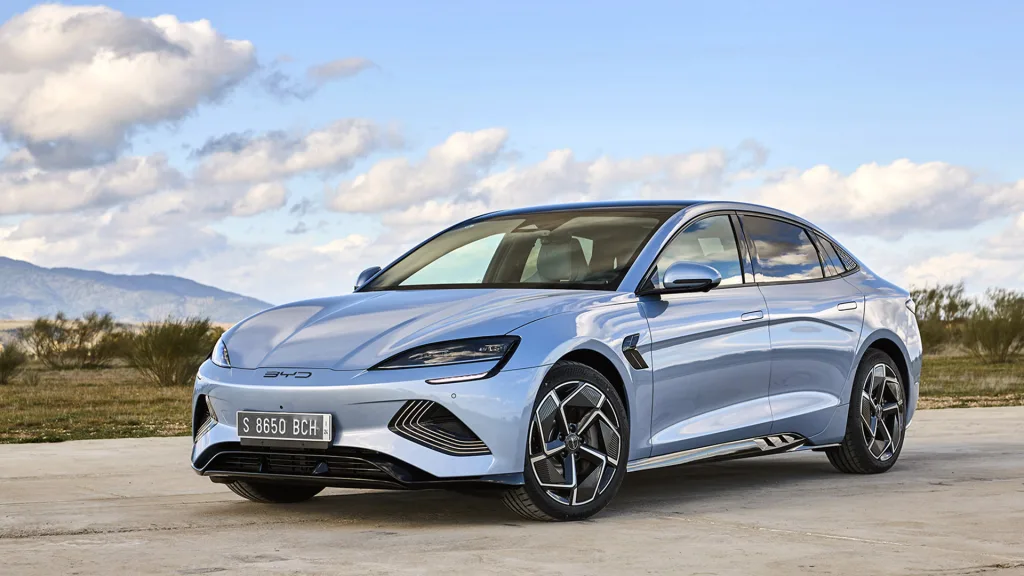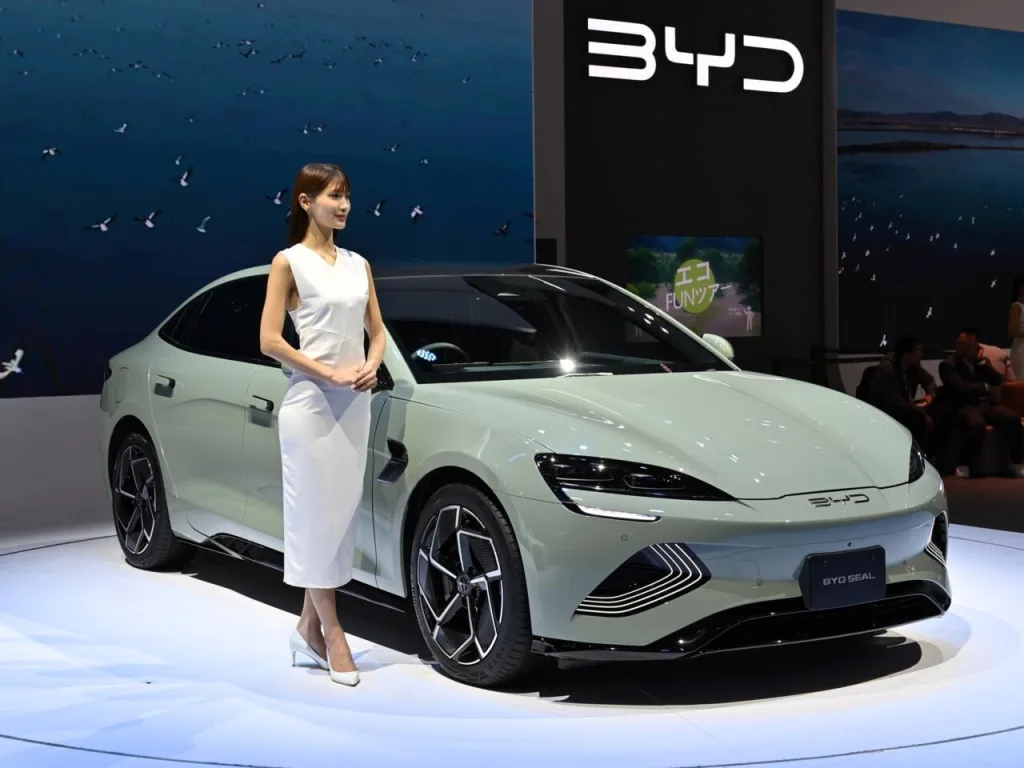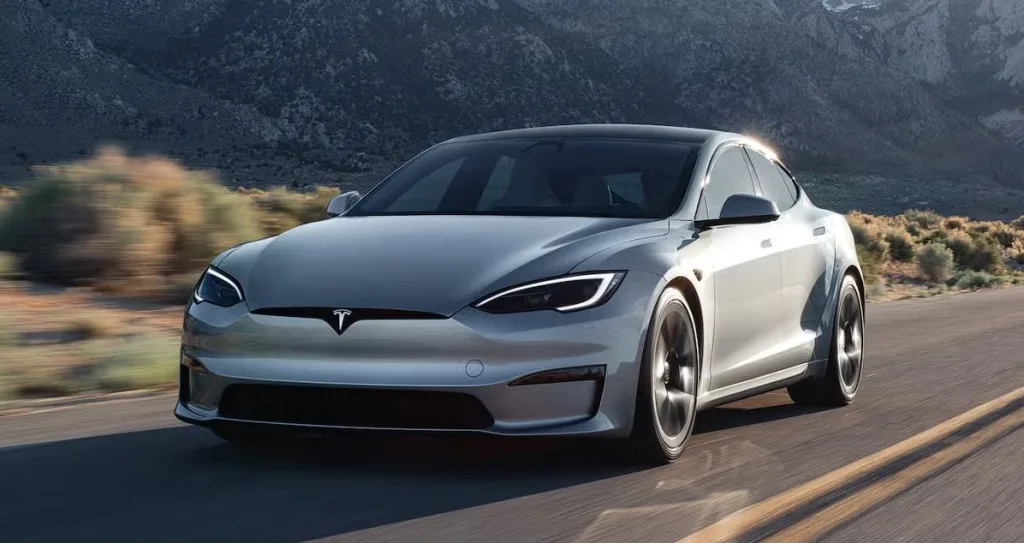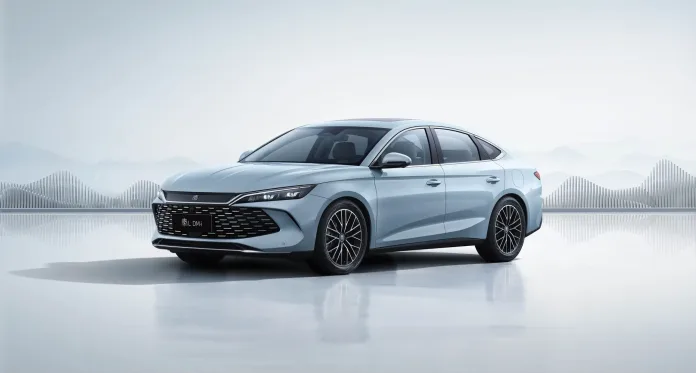The electric vehicle landscape has undergone a seismic shift. Standing in BYD’s gleaming Shenzhen headquarters, I watched workers assemble sleek electric sedans with practiced efficiency. Just five years ago, few outside China would have predicted this scene would represent the world’s largest EV manufacturer by volume—one that would eventually overtake Tesla, the company that had become synonymous with electric mobility.
“We don’t just build cars,” explained Li Feng, a senior BYD executive who guided me through the facility. “We’re building an entirely new transportation ecosystem.” His words carried weight as we passed by a wall displaying the company’s latest achievement: surpassing $107 billion in annual revenue, officially eclipsing Tesla’s $97.7 billion.
This milestone isn’t merely about financial figures. It represents a fundamental power shift in the global automotive industry, with profound implications for consumers, investors, and policymakers worldwide.
The numbers tell a compelling story. In 2024, BYD sold approximately 4.27 million vehicles—a mix of fully electric and hybrid models—nearly doubling Tesla’s 1.79 million units. This achievement is even more remarkable considering BYD’s relative obscurity in Western markets just a few years ago.
| Metric | BYD | Tesla |
|---|---|---|
| Annual Revenue (2024) | $107 billion | $97.7 billion |
| Net Profit | $5.56 billion | $7.6 billion |
| Vehicles Sold | 4.27 million | 1.79 million |
| YoY Net Profit Increase | 34% | Not reported |
“The competition between BYD and Tesla isn’t just about two companies,” noted Zhang Wei, an automotive industry analyst I spoke with in Shanghai. “It’s about two different approaches to electrification—and perhaps two different visions for the future of transportation.”
Revolutionary EV Charging Technology from BYD
Walking through BYD’s research and development center reveals why the company has gained such momentum. Engineers demonstrate their next-generation charging system, capable of delivering 232 miles of range in just five minutes—a technological leap that addresses one of the primary barriers to EV adoption.
“Range anxiety and charging time have been the two biggest concerns for potential EV buyers,” explained Dr. Chen, head of BYD’s charging technology division. “We’ve focused intensely on solving both problems simultaneously.”
This focus on practical innovation extends throughout BYD’s approach. While Tesla has built its brand on cutting-edge technology and premium positioning, BYD has pursued a different strategy: making electric vehicles accessible to the mass market without compromising on key features.
The contrast becomes clear when comparing recent product launches. BYD recently introduced the Qin L sedan with a price tag of just 11,800 yuan (approximately $16,517). Meanwhile, the basic Tesla Model 3 in China costs 235,500 yuan—more than double the price. Despite this significant price difference, the Qin L offers a competitive driving range of 545 km compared to the Model 3’s 634 km.
“We’re democratizing electric mobility,” said Wang Chuanfu, BYD’s founder and chairman, during a recent product launch I attended. “The transition to sustainable transportation can’t happen if electric vehicles remain luxury items.”

Declining Tesla Market Share in China: Analysis
Tesla’s journey in China illustrates the challenges Western manufacturers face in this rapidly evolving market. When Tesla opened its Shanghai Gigafactory in 2019, it seemed poised to dominate China’s premium EV segment. The reality has proven more complicated.
| Year | Tesla’s Market Share in China |
|---|---|
| 2022 | Over 16% |
| 2023 | 7.8% |
| 2024 | 6.1% |
| February 2025 | 4.3% |
This dramatic decline reflects both intensifying competition and shifting consumer preferences. During visits to dealerships in Beijing and Shanghai, I observed firsthand how Chinese consumers increasingly favor domestic brands that offer comparable technology at lower prices.
“Tesla still has strong brand recognition, but that alone isn’t enough anymore,” explained Liu Jian, a Tesla owner I met at a charging station outside Beijing. “My next car will probably be Chinese. The value proposition is just too compelling to ignore.”
Tesla’s challenges extend beyond pricing. The company has faced regulatory scrutiny, including concerns about data security and manufacturing quality. Meanwhile, Chinese manufacturers like BYD have benefited from government policies designed to foster domestic EV champions.
“The playing field isn’t level,” acknowledged a Tesla representative who requested anonymity. “We’re competing against companies that receive significant government support while navigating a complex regulatory environment as a foreign entity.”
Why the Chinese Electric Vehicle Market Leads Globally
China’s dominance in the electric vehicle sector didn’t happen by accident. It resulted from deliberate policy choices and massive investments spanning more than a decade.
“The Chinese government identified electric vehicles as a strategic sector where China could leapfrog established automotive powers,” explained Dr. Zhang Min, an economist specializing in industrial policy at Beijing University. “They’ve executed that vision with remarkable consistency.”
Since 2009, the Chinese government has invested over $230 billion into the EV and battery sectors through subsidies, tax breaks, and infrastructure development. This support has created a fertile ecosystem for companies like BYD to thrive.
The results speak for themselves. China now accounts for over 60% of global EV sales, with domestic retail sales reaching 10.9 million units in 2024—a 40% increase from the previous year. Industry projections suggest EVs could represent 60% of new car sales in China by 2025, potentially rising to 85% by 2030.
This market dominance provides Chinese manufacturers with economies of scale that are difficult for competitors to match. During a tour of BYD’s battery production facility, I witnessed how vertical integration—controlling everything from raw material processing to final assembly—gives the company significant cost advantages.
“We’re not just an automaker,” explained the facility manager. “We’re a clean energy company that happens to make vehicles. This integrated approach allows us to optimize the entire value chain.”

Record-Breaking BYD Sales Figures Explained
The February 2025 sales figures highlight the diverging trajectories of BYD and Tesla. While BYD sold 322,846 vehicles—representing a staggering 164% year-over-year increase—Tesla delivered just 30,688 units, marking a 49% decline from the previous year.
| Metric | BYD (Feb 2025) | Tesla (Feb 2025) |
|---|---|---|
| Cars Sold | 322,846 | 30,688 |
| YoY Growth | +164% | -49% |
| Market Position | #1 in global EV sales | #2 in global EV sales |
These numbers reflect BYD’s successful expansion beyond China. Despite not selling passenger cars in the United States due to punitive tariffs, the company has made significant inroads in Europe, Southeast Asia, and Australia.
“We’re witnessing the globalization of Chinese EV brands,” noted automotive journalist Maria Rodriguez during an industry conference in Barcelona. “Five years ago, most Europeans couldn’t name a single Chinese car brand. Today, BYD billboards are everywhere.”
This global expansion hasn’t been without challenges. BYD faces skepticism about quality in some markets and political resistance in others. However, the company’s strategy of entering markets with affordable, feature-rich vehicles has proven effective in overcoming initial consumer hesitation.
“The first wave of customers are often price-sensitive early adopters,” explained BYD’s European marketing director during a product launch in Paris. “Once they experience the vehicles and share their positive impressions, mainstream acceptance follows.”
Tesla EV Strategy: Responding to Chinese Competition
Tesla isn’t standing still in the face of this competition. The company is reportedly developing a more affordable version of its Model Y specifically aimed at regaining market share in China. Additionally, Tesla continues to leverage its strengths in software development and autonomous driving technology.
“Tesla’s advantage has always been its software-first approach,” explained automotive technology analyst Sarah Chen. “Their vehicles improve over time through over-the-air updates in ways that competitors struggle to match.”
During a recent investor call, Elon Musk acknowledged the competitive pressure but remained defiant: “We’ve faced skepticism and competition throughout our history. What matters is continuing to build the best possible products while driving down costs through innovation.”
Tesla’s Supercharger network—widely regarded as superior to competing charging infrastructure in most markets outside China—remains a significant advantage. The company’s brand cachet also continues to command premium pricing in North America and Europe.
“Tesla isn’t just selling cars; they’re selling a vision of the future,” noted brand strategist Michael Wong. “That emotional connection with customers is difficult to quantify but incredibly valuable.”

The Electric Vehicle Market Shift: East vs West
The competition between BYD and Tesla reflects broader geopolitical and economic tensions. As I traveled between China and the United States researching this story, the contrasting approaches to electric vehicle development became increasingly apparent.
In China, electric mobility is viewed as a national strategic priority with coordinated government support. Charging infrastructure has expanded rapidly, with standardized systems that work seamlessly across brands. Consumer incentives have made EVs increasingly affordable for middle-class buyers.
The Western approach has been more fragmented, with varying levels of government support and a patchwork of charging standards. While premium EVs have gained traction, mass-market adoption has been slower than in China.
“The risk for Western automakers is falling too far behind,” warned industry consultant James Miller. “Once you lose manufacturing scale and supply chain advantages in a capital-intensive industry like automotive, they’re extremely difficult to regain.”
This divergence extends to industrial policy. China’s approach involves direct government investment and coordination across the EV supply chain. Western nations have generally relied more on market forces, though recent legislation like the U.S. Inflation Reduction Act signals a shift toward more active government involvement.
“We’re seeing a fundamental rethinking of industrial policy in the West,” noted economist Patricia Johnson. “The success of China’s EV sector has challenged assumptions about the effectiveness of hands-off approaches to strategic industries.”

The Future of the BYD vs Tesla Competition
As BYD and Tesla continue their global competition, several factors will likely shape the outcome:
- Technology Innovation: Both companies continue to invest heavily in battery technology, autonomous driving, and manufacturing processes. Breakthroughs in any of these areas could shift competitive dynamics.
- Market Access: Political tensions and trade policies will influence where and how these companies can compete. Tariffs, local content requirements, and security concerns all impact market access.
- Consumer Preferences: As EVs move from early adopters to mainstream consumers, priorities may shift from technological novelty to practical considerations like affordability and reliability.
- Infrastructure Development: The pace of charging infrastructure development in different regions will influence adoption rates and brand preferences.
- Regulatory Environment: Emissions regulations, incentive programs, and safety standards will continue to evolve, potentially favoring different approaches to electric mobility.
What’s clear is that the competition between these companies will drive innovation and accelerate the transition to electric transportation. As Wang Chuanfu told shareholders recently, “Competition makes us stronger. It forces us to innovate faster and become more efficient.”
Elon Musk expressed similar sentiments during Tesla’s annual meeting: “The goal was never to be the biggest. It was to accelerate the world’s transition to sustainable energy. If others help achieve that goal, that’s a good thing.”
As I concluded my research, visiting dealerships and talking with consumers across multiple continents, one thing became evident: the real winners in this competition are consumers, who now have more affordable and capable electric vehicles to choose from than ever before.
Also Read: Tata Nexon vs MG Windsor Comparison: Detailed Guide in 2025
Frequently Asked Questions About BYD vs Tesla
How did BYD surpass Tesla in sales and revenue?
BYD surpassed Tesla by focusing on affordable electric vehicles and leveraging China’s massive domestic market. In 2024, BYD reported revenues of $107 billion compared to Tesla’s $97.7 billion, and sold 4.27 million vehicles versus Tesla’s 1.79 million. BYD’s strategy of offering both fully electric and hybrid vehicles at competitive price points has allowed it to capture a broader segment of the market.
What advantages does BYD have over Tesla?
BYD’s main advantages include vertical integration (controlling its entire supply chain from batteries to vehicles), lower pricing, strong government support in China, and a diverse product lineup that includes both EVs and hybrids. BYD also benefits from China’s well-developed charging infrastructure and has recently introduced fast-charging technology that can add 232 miles of range in just five minutes.
Why is Tesla losing market share in China?
Tesla’s market share in China has declined from over 16% in 2022 to just 4.3% in February 2025 due to intense competition from domestic manufacturers offering comparable vehicles at lower prices. Additional factors include regulatory challenges, shifting consumer preferences toward local brands, and China’s strategic support for domestic EV manufacturers.
Will BYD enter the US market?
BYD currently does not sell passenger cars in the United States due to high tariffs and political tensions. While the company has expressed interest in the US market, significant barriers remain, including a 100% tariff on Chinese-made vehicles announced in May 2024. BYD does sell electric buses in the US market and has a manufacturing facility in California for this purpose.
How has China supported its domestic EV industry?
China has invested over $230 billion in the EV and battery sectors since 2009 through subsidies, tax incentives, infrastructure development, and research funding. The government has also implemented policies requiring foreign automakers to partner with local companies, enabling technology transfer. Additionally, China has developed comprehensive standards for charging infrastructure and set aggressive targets for EV adoption.
Can Western automakers compete with Chinese EV manufacturers?
Western automakers face significant challenges competing with Chinese EV manufacturers on price, but maintain advantages in brand recognition, dealer networks, and customer loyalty in their home markets. To remain competitive, Western companies are investing heavily in dedicated EV platforms, battery technology, and manufacturing efficiency. Recent policy initiatives like the US Inflation Reduction Act aim to strengthen domestic EV production capabilities.
BYD’s rise signals a fundamental shift in the global automotive hierarchy, challenging the century-long dominance of American, European, and Japanese manufacturers. It demonstrates that the transition to electric vehicles has created an opportunity for new players to establish leadership positions. This shift will likely accelerate industry consolidation, increase pressure on traditional automakers to transform their businesses, and potentially reshape global automotive supply chains.


